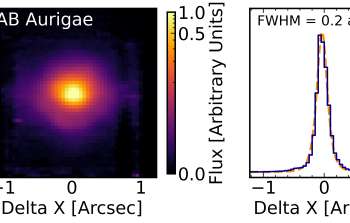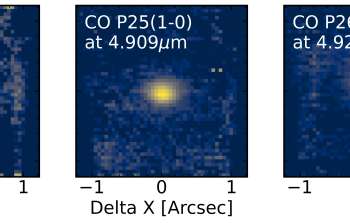sci24023 — Announcement
GNIRS Acquires Higher-Resolution 3-D Glasses
March 8, 2024
The Gemini Near-InfraRed Spectrograph (GNIRS) has been an incredibly productive instrument for the International Gemini Observatory for the last two decades. Since it was re-commissioned at Gemini North in 2010, GNIRS has primarily had three observing modes: imaging, longslit, and cross-dispersed spectroscopy. Over the past five years, Gemini Observatory and the GNIRS team, under the auspices of the Gemini Instrument Upgrade Program, have worked with a team based at Durham University in the UK on the fabrication, installation, and commissioning of two new integral field units (IFUs) to be used with GNIRS.
The first of the two, a low-resolution integral field unit (LR-IFU) was released for public use starting in the 2024A semester, and the first on-sky community science targets are currently awaiting observation in the queue. The LR-IFU optical sub-system reformats the light from a 3.15 x 4.80 arcsec rectangular field into a linear pseudo-slit comprising 21 slices each of width 0.15 arcsec and length 4.80 arcsec. These slices are rearranged in the reduction process into a 3D datacube providing spatially resolved spectroscopy in one band, i.e., X, J, H, or K at 𝜆/Δ𝜆~1500–2000 (or a portion of a band at 𝜆/Δ𝜆~6000) over the entire field of view. The LR-IFU mode is now fully open for both regular queue and Fast Turnaround proposals and is compatible with both natural and super-seeing ('LGS + P1') modes.
The second IFU, the higher-resolution of the two IFUs (HR-IFU), is now open for community science for regular queue starting in 2024B and in Fast Turnaround in May 2024. The HR-IFU optical subsystem is designed similarly to its lower resolution counterpart and comprises 25 slices each of width 0.05 arcsec and length 1.80 arcsec, which results in a rectangular field of view of 1.25 x 1.80 arcsec. While the HR-IFU has a smaller field of view than the LR-IFU, the HR-IFU is designed to be fully compatible with observations behind traditional adaptive optics modes (Natural Guide Star, Laser Guide Star), providing a ~0.1 arcsec delivered FWHM, and is also compatible with Gemini’s super-seeing mode. The HR-IFU provides not only the potential for superior spatial resolution relative to the LR-IFU, but also spectral resolution that is 3–4 times greater than equivalent LR-IFU observations (up to 𝜆/Δ𝜆~19,000).
The HR-IFU provides the additional capability of observations in the mid-infrared (2.5–5.4 μm), a mode currently not offered for the LR-IFU. This mode is currently unique among 8-meter-class telescopes in the northern hemisphere. Though this mode is offered in natural seeing only, because of the superb conditions that exist on Maunakea near-diffraction-limited observations at these wavelengths are possible even without the use of adaptive optics. Recent science verification observations of the AB Aur protoplanetary disk at 4.9 μm (see Figure), for example, resulted in a delivered FWHM of ~0.2 arcsec, nearly reaching the diffraction limit of the Gemini North telescope at 4.9 μm and exceeding the resolution of the James Webb Space Telescope at equivalent wavelengths.
The new modes offered by the two new GNIRS IFUs are considerably more flexible than those that had been offered in the recently retired Gemini North Near-infrared Integral Field Spectrograph (NIFS). Combined with the flexibility of GNIRS in terms of wavelength coverage and resolution, these modes make GNIRS a formidable instrument for exploring the Universe in 3D! See an example here.


GNIRS HR-IFU stacked images of the protoplanetary disk AB Aurigae (AB Aur) showcasing compact CO ro-vibrational line emission and disk continuum emission in the M band. Top: Emission map at 4.9 μm of the AB Aur complex originating from gas and dust present in the disk, as well as stellar photospheric emission. The exceptional seeing at Maunakea, coupled with the high-spatial sampling of the HR-IFU, delivered a nearly diffraction-limited image of the source. Bottom: Emission map of the CO fundamental ro-vibrational P22 transition at 4.8760 μm; P25 at 4.909 μm, and P26 at 4.920 μm. Each emission line map is generated by integrating over seven spectral channels centered on the line wavelength and subtracting the continuum emission. The ability of the GNIRS HR-IFU to disentangle faint, narrow line emission in the M band will enable detailed characterization of gas in these planet forming disks. Image/data Credit: GNIRS HR-IFU commissioning team, Durham IFU team, and S. Brittain.
About the Announcement
| Id: |
ID
sci24023
|

